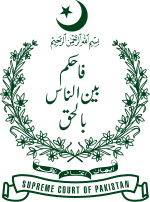
Back المحكمة العليا الباكستانية Arabic পাকিস্তান সুপ্রিম কোর্ট Bengali/Bangla Oberster Gerichtshof Pakistans German Corte Suprema de Pakistán Spanish دیوان عالی پاکستان Persian Cour suprême du Pakistan French בית המשפט העליון של פקיסטן HE पाकिस्तान का सर्वोच्च न्यायालय Hindi Mahkamah Agung Pakistan ID Corte suprema del Pakistan Italian
| Supreme Court of Pakistan | |
|---|---|
| عدالتِ عظمیٰ پاکستان | |
 Emblem of the Supreme Court of Pakistan | |
 Flag of the Supreme Court of Pakistan | |
 | |
| 33°43′41″N 73°05′55″E / 33.72806°N 73.09861°E | |
| Established | 14 August 1947 |
| Jurisdiction | Civil, criminal, constitutional and advisory |
| Location | Red Zone, Islamabad-44000, |
| Coordinates | 33°43′41″N 73°05′55″E / 33.72806°N 73.09861°E |
| Motto | فاحكم بين الناس بالحق "So judge between the people in truth" (Quran 38:26) |
| Composition method | Judicial Commission of Pakistan |
| Authorised by | Constitution of Pakistan |
| Appeals to | President of Pakistan for Clemency/Commutation of sentence |
| Appeals from | High Courts of Pakistan |
| Judge term length | Compulsory retirement at 65 years of age |
| Number of positions | 34 |
| Website | www.supremecourt.gov.pk |
| Chief Justice of Pakistan | |
| Currently | Yahya Afridi |
| Since | 26 October 2024 |
| Lead position ends | 25 October 2027 |

The Supreme Court of Pakistan (Urdu: عدالتِ عظمیٰ پاکستان; Adālat-e-Uzma Pākistān) is the apex court in the judicial hierarchy of the Islamic Republic of Pakistan.[1]
Established in accordance with Part VII of the Constitution of Pakistan, it has ultimate and extensive appellate, original, and advisory jurisdictions on all courts (including the high courts, district, special and Shariat court), involving issues of laws and may act on the verdicts rendered on the cases in context in which it enjoys jurisdiction. In the court system of Pakistan, the Supreme Court is the final arbiter of legal and constitutional disputes as well as final interpreter of constitutional law, and the highest court of appeal in Pakistan.
In its modern composition, the Supreme Court is incorporated of Chief Justice of Pakistan, sixteen justices and two ad hoc who are confirmed to their appointment by the President upon their nominations from the Prime Minister's selection based on their merited qualifications. Once appointed, justices are expected to complete a designated term and then retire at 65 years old, unless their term is terminated through resignation or impeachment by the supreme judicial committee resulted in a presidential reference in regards to the misconduct of judge(s). In their discourse judgement, the justices are often categorized as having the conservative, textual, moderate, and liberal philosophies of law in their judicial interpretation of law and judgements.: 1915 [2]: 436 [3]
The Supreme Court has a permanent seat in Islamabad and meets at the Supreme Court Building at the Red Zone.[4]
- ^ "Chapter 2: "The Supreme Court of Pakistan." of Part VII: "The Judicature"". pakistani.org. Archived from the original on 22 October 2017. Retrieved 11 May 2018.
- ^ Ali, Tariq (2012). The Duel: Pakistan on the Flight Path of American Power. London [uk]: Simon and Schuster. ISBN 9781471105883.
- ^ Ramraj, Victor V.; Thiruvengadam, Arun K.; Lombardi, Kevin (2010). "Islamism as a response to emergency rule in Pakistan" (google books). Emergency powers in Asia : exploring the limits of legality (1. publ. ed.). Cambridge [U.K.]: Cambridge University Press. p. 500. ISBN 9780521768900.
- ^ Cite error: The named reference
Supreme Court of Pakistan Presswas invoked but never defined (see the help page).